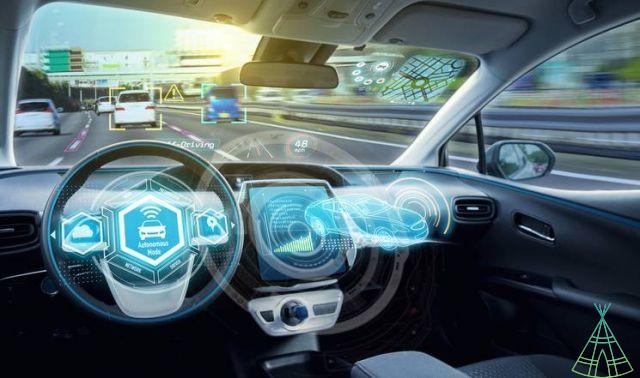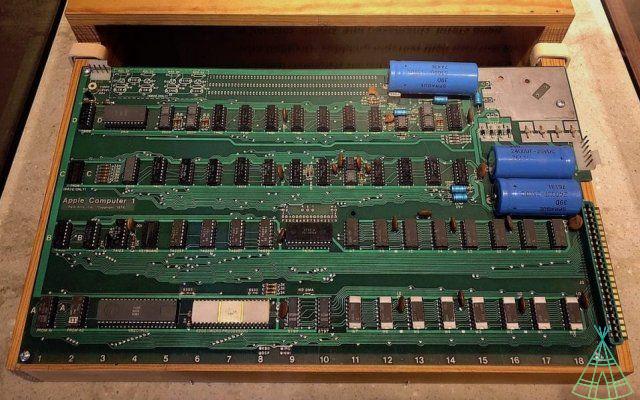
Automakers around the world, and not just them, are stepping up to get you to stop driving – and for your own good. The development of autonomous cars brings together names such as Honda, Toyota, Tesla, Hyundai, Volvo, Waymo (a partnership between Google and Fiat Chrysler), BMW, Volkswagen, General Motors, Ford, Geely, Mercedes-Benz, Uber (offers of free rides a single driver) and much more.
For these companies and projects, the word of the moment is mobility. They seek to develop an automation process in driving so that cars effectively drive themselves, without any human interference. And for this, they take into account not only the comfort and practicality part, but also safety issues.
For you to understand autonomous cars, the Technology Refugee prepared a comprehensive guide. Check out!
What are autonomous cars?
Autonomous cars are those that offer some important autonomous functions of driving and driving without any human interference. Depending on the level of autonomy, vehicles are configured without steering wheel and pedal items. On some recent concepts, such ponents can emerge from the roof, or under the windshield, as we saw on Audi's Grandsphere.
Much automation already occurs in most high-end models. However, 100% autonomous driving is not yet to be achieved. In any case, the focus of automation in driving is to free you from the task (or pleasure) of driving.
How do self-driving cars work?
One of the ideal ways to have an approach on how autonomous cars work is by observing what the Society of Automotive Engineers (SAE) says. This organization is a reference in automotive engineering studies and standardizes detailed definitions for six levels of autonomous driving, ranging from zero to 5.
Thus, the dependency on having a driver in the car driving decreases as the level of driving increases. For example, a driver support systems level 0 vehicle means that the car is fully manual and fully dependent on a human (you must steer, brake, or accelerate as necessary to maintain safety).
Like the previous one, levels 1 (assisted steering) and 2 (partial automation) require an active driver with his hands on the steering wheel. That is, you are always responsible for the operation of the car, overseeing the technology at all times and taking full control of the car when necessary.
At this point, features such as lane centering assist (to keep the car in the lane) and adaptive cruise control (which keeps the car at a safe distance from the traffic ahead) are starting to appear. At level 1, the vehicle has one or the other.
At level 2, these features work together in cars equipped with advanced steering assistance systems (ADAS). One well-known technology that falls into this category is Tesla's Full Self-Driving (FSD).
The technology takes full control of driving without human supervision at levels 3 (conditioned automation), 4 (advanced automation) and 5 (full automation). In other words, the driver doesn't need to have their hands on the steering wheel at all times. However, level 3, if the vehicle alerts and requests that a person take control of the vehicle, the driver must be prepared and able to do so.
Already from level 4, the science fiction part starts to appear. Drivers can now, for example, take a nap while the car drives itself (in certain areas and subject to certain restrictions, however). The car must be able to bring itself to safety if the driver is unable to take control in an emergency.
Level 5 means a vehicle can drive itself anywhere and in all conditions without any human interaction. Vehicles with this maximum automation rating are not limited by geofencing or affected by weather and comfortably and efficiently transport humans without the need for someone to take the driver's seat.
The only human involvement the automobile will be in defining a destination. Voice walks should exist, in addition to other types of interaction with the system inside the car, where the least you need to do is drive.
What is the technology of autonomous cars?
To be approved by the authorities, an autonomous vehicle needs to be able to work in different environments. Therefore, companies need to carry out batteries of the most different tests, in controlled or open places, using technologies such as sensors, radars and security systems.
Among the tasks that must be automated are cornering, braking or accelerating, and the autonomous control must be aware of everything that happens around the vehicle. For this, software based on resources or artificial intelligence work together with sensors and radars installed by the car body.
One of the main items in this group is the LiDAR sensor, which uses reflected light to measure distance and depth for camera effects and augmented reality – and thus detect obstacles on the track.
There is also the use of ultrasonic sensors for geolocation, in addition to tools configured for intelligent environments, for example, on tracks in cities around the planet.
The software part is responsible for processing the information, having the answer for the autonomous vehicle setting the best path, moment of action (braking, turning right, accelerating, keeping the lane, keeping the distance from the other car in front) . In addition, there is unification between vehicles, as the systems increase their connectivity and networking potential.
An overview of autonomous cars in Brazil
Have you ever wondered if there is an autonomous car in Brazil? Know that yes. In Brazil, taking into account the SAE classification, there are autonomous cars in circulation, driver assistance that can be learned at levels 1 and 2. Thus, these are vehicles that require the driver's hands on the steering wheel.
Incidentally, not only the technological issue offers a field of little adherence of autonomous cars in our country, there are also ethical, infrastructure and legislation issues to be observed. Well-evaluated highways, such as Bandeirantes, in the state of São Paulo, could receive highly automated vehicles.
There are details about what it's like to use an autopilot in Brazil in a recent article of ours, when we talked to the driver who said he wasn't sleeping in a Model 3 caught on the Imigrantes highway. Entrepreneur Rafael Zamarian Leonhardt even told what it's like to have a Tesla in Brazil and said that he uses the resource 100% of the time on the road.
“In Brazil, point-to-point navigation does not work in the US. He even overtakes at the request of the arrow, goes to the side lane if it is dotted after the arrow, to try to take an access, like exiting the Rodoanel. But it does not browse by address. That is, it does not take a route”, he explained.
Leonhardt said he prefers to turn off the Tesla car's automatic system (which is not the FSD, available to select drivers) on very poorly signposted streets or on streets with no signs at all. "But on main roads and in traffic, it usually works better than a human being pissed off in traffic."
“Autopilot made me a better driver! My fines for speeding over the limit are over and I'm always on the road 10 km/h below the maximum limit, more aware, calmer and much more responsible than when I didn't have it”, he reported.
Know the pros and cons of self-driving cars
In this sense of benefits that autopilot offers, we can make a list of advantages of autonomous cars (and disadvantages, too).
Advantages
Vehicles interact with each other
Faced with a powerful configuration on the basis of implementing autonomous driving systems, there is also advanced technology in the connection part. Cars that drive alone will be able, depending on configuration, to run closer to each other, moving in peloton style to get people to their destinations, for example.
save time
In addition to allowing those who would be the driver to perform tasks that they would not be able to perform if they were driving the vehicle, the autonomous car can perform functions on its own. parking alone (we have seen advances in a Volkswagen 3.0 software that allows the driver to teach the vehicle to park itself), not taking the person's time for this. At the same time, cars receive traffic information, automatically divert from troublesome routes, and more.
are safer
Human inaccuracies and mistakes in traffic caused by inattention from tired drivers or other health problems are eliminated. Automation offers a considerable decrease in the margin of error in driving, especially as the car's interaction with smart cities and environments increases.
are more sustainable
The time savings we saw above also have to do with less time for the car running, in operation, using fuel (energy) – therefore, there is less environmental impact. Efficiency means less need for refills or refueling.
The focus on the development of autonomous cars also follows the development of electric cars and those aimed at zero emissions, as well as those powered by hydrogen. The production of these vehicles does not require a lot of resources, also considering that many automotive parts today come from recycled materials.
Advance in integration
On-board unication systems in autonomous cars have advanced capabilities that go beyond the interaction between vehicles that we saw above. We have the integration part of the traffic center cars and maps, to look for better routes and the over-the-air (OTA) updates part, for the integration of the car's software without having to take it to an authorized automaker.
Not to mention the connected services that are growing exponentially, capturing the desires of drivers who seek privacy, convenience and peace of mind. Along these lines, there are advances in streaming services, Wi-Fi, a more advanced computerized network (including 5G premises) and so on. In addition, people inside a high-level autonomous vehicle can interact with each other without worrying about traffic, send emails, hold virtual meetings.
Less maintenance costs
In addition to the reduction in fuel costs (given the electrical profile of autonomous cars) by optimizing energy use and wear and tear, over time, there is less maintenance costs. Such models will visit the workshop much less.
It will not be necessary to know how to drive
Well, here we are already talking about the most advanced levels in the SAE classification. Because, really, no one inside a level 5 self-driving car will need to get a license to travel. At most, they will need to memorize voice commands so that the vehicle performs some action not previously programmed.
Disadvantages
Price
Self-driving cars offer cutting-edge technology, which is no longer cheap. The electrical profile (disregarding cruise control systems) also places these vehicles at the top of values for people.
membership application
The changes necessary for the implementation of autonomous cars in the day-to-day life of cities gain a special tone in terms of traffic legislation and also infrastructure. In addition, the driver may have difficulties when it comes to trusting that the vehicle's intelligence “is greater” than his to be able to take over driving.
Risco
The ethical issue in the development of autonomous driving software goes in the same direction as the creation of other putative systems. So, how risky it is to have a portamento algorithm in different situations – choosing between saving the driver or a pedestrian in extreme situations.
vulnerability to attacks
Another problem is the use of information collected by self-driving cars and the systems to which they are connected. In security breach scenarios, improper access to data can be illustrated by the possibility of a hacker accessing and controlling an autonomous car.
maintenance complexity
There may be the benefit of fewer trips to the garage for a self-driving car, but technicians will have to possess a high degree of knowledge to carry out the proper procedures. Not only in terms of parts exchange, but also in systems configuration.
Meet existing models of self-driving cars
There are many self-driving cars at different levels around the world (of course those in the lowest rankings, with driving assists plus driver assists are the majority). high competence of autopilot, there are those in tests, others in concept and there are some that have even received authorization to run.
In addition to Tesla cars that have the FSD, another level 2 car that we can mention is Volvo's XC90 (which has also been working to make its famous trucks that drive without a human driver).
In 2020, for example, Honda received permission to market its luxury Legend sedan in Japan, equipped with a level 3 autonomy in the direction. It is important to note that, over there, it was necessary to change the legislation for this implementation by the automaker.
Meanwhile, Mercedes-Benz will already be able to offer a Level 3 autonomous driving system in Germany later this year, and this wants to qualify the hands-free technology abroad. Initially on the S-Class and EQS models, the Ride Pilot will operate in heavy traffic, on pre-mapped stretches of road, at speeds of up to approximately 60 km/h. The software has a parallel competence to Volvo's Ride Pilot.
A considered direct rival to the Mercedes-Benz S-Class vehicles, Hyundai's Genesis G90 is on track to earn a Level 3 driving range rating. That is, the South Korean automaker's car is a level above those that have Tesla's FSD, which means a great advance.
Speaking of Elon Musk's company, the CEO promised at the end of last year a “leap” of its software to level 4 in 2022. Despite Tesla's effective competence regarding the technologies of its vehicles, Musk is also known for having declared numerous times (at least once a year, since 2014) that “a fully autonomous car will be launched next year”.
In this level 4, we had a very clear demonstration in the last Olympics, Toyota's e-Pallete autonomous bus, used to transport athletes inside the Olympic Village. features o detection of other cars and pedestrians in the vicinity and automatic braking when necessary, even without the need for a driver, each of the models had an operator on board for safety.
The Audi Gransphere concept can be considered a “lounge on wheels”, due to its level 4 autonomous competence. This highlight is in line with what we saw above about the benefits of autonomous cars, a model that really offers people inside the luxurious cabin the opportunity for moments of pure relaxation without worrying about the traffic around.
Another vehicle that we can mention here is the Robocar concept, being developed by Baidu, the “Google of China”, in partnership with the automaker Geely. Among the model's details are two small pop-up towers on the hood containing the LiDAR radar (vital for autonomous driving technology).
By the way, speaking of Google, the American company is also working on an autonomous car in partnership with Waymo. Not only that. At the end of 2021, a partnership was announced with Zeekr, the luxury brand of the Chinese automaker Geely, focusing on the development of a vehicle where passengers will have “an interior without a steering wheel and pedals and plenty of space for legs and reclining seats, screens and chargers within arm's reach and a comfortable, easy-to-set-up vehicle cabin.” Something that meets level 5 traits.
One of the most recent standouts in what is the highest grade of self-driving classification is the M7, from Chinese startup Weltmeister Motor. The vehicle is equipped with 32 sensors.
There are three LiDAR radars, 12 ultrasound sensors, 4 360-degree cameras and a high-precision GPS module equipping the Chinese model (which is being prepared to debut in 2023). Driving this is Nvidia's Driv Orin-X chipset, which is already used by other automakers like Volvo and Nio.
What was the first self-driving car to be created?
The US Army demonstrated a radio-controlled three-wheel trailer called the Radio Air Service at an Ohio air force base in 1921. Even though many historians place it as the first driverless motor vehicle, it can hardly be considered a car.
As early as 1925, military engineer Francis Houdina exhibited a remote-driven 1926 Chandler. The prototype – which was called the American Wonder – went down Broadway in New York while other drivers and pedestrians wondered what was happening. An engineer in a second car used radio signals to control the vehicle, which the press dubbed the Ghost Car. However, we can consider this a large version of the “remote control cart”.
In the 1970s and 1980s, programming and data processing technology advanced, allowing the first truly autonomous cars to emerge. These new vehicles were equipped with sensors, processors and cameras capable of detecting, for example, the existence of a car ahead and avoiding possible collisions.
This time, the car was not dependent on external factors such as the other lead vehicle or sensors on the roads. From then on, for the first time, a car drove on the roads without any human interference, being the NavLab 1, launched in 1986. It reached a maximum of 32 km/h, and the technology is basically the same used until today – exception of geolocation (GPS).
Self-driving cars and Artificial Intelligence (AI)
Faced with so many assumptions and realities with the most current autonomous cars, it is necessary to remember Artificial Intelligence (AI) acting in driving systems. For that, we can point to Nvidia's Drive Concierge and Drive Chauffeur AIs. They are the company's entry into the automobile sector and will act on the automatic pilot of the Orin system, developed by the American semiconductor manufacturer.
The focus of these works gives a dimension of how artificial intelligence is used in the general development of technologies for autonomous cars. For example, Drive Concierge will be relying on AI for people to “drive” by voice. That is, an assistant capable of operating both functions associated with the telephone, making a call or searching, and capable of driving alone.
Your decisions will not only be focused on the traffic, but also on the driver: the car's internal cameras assess whether it is necessary to take action (if your level of attention to traffic is affected). In that case, the AI will not only stop you from making mistakes, it will encourage you to take a break.
This system-on-a-chip cars will also remind you not to forget your purse, cell phone or wallet in the back seats. In that function of parking alone, there is also the performance of artificial intelligence in the autonomous car.
Drive Chauffeur is a unique traffic assistant system. Interacting with the Concierge, it creates 3D projections of the road while operating autonomously, and makes risk assessments during the journey.
How important is 5G for the development of autonomous cars?
Within the perspective of autonomous cars operating in today's 4G networks, the situation is even more advanced with 5G (the for everything in our lives, we saw it here).
The rapid traffic of information between systems is capable of creating the necessary connections for many of the most essential resources in vehicles and in the ecosystem where they operate. We are also talking about unification between autonomous cars, between the car and an urban traffic center, between the car and the dealership, between people inside the car and people outside the car, and so on.
5G would allow passengers to shop online at the supermarket using data generated by the refrigerator at home, for example. Entertainment services, streaming, and digital financial transactions are also expected to grow further.
Virtual reality and augmented reality, together with systems connected via 5G and IoT, will completely transform the world we know today, including in traffic.
Internet of Things and autonomous cars: what are they related?
You see, it is through the Internet of Things (IoT) that an autonomous car shares information about the road, which has already been mapped. This information includes the route traveled, traffic and situation of obstacles, for example. The sharing of this information between vehicles and the ecosystem in general connected to the IoT is carried out wirelessly, in a cloud system, to be analyzed and put to use, improving automation.
Radar lasers, sensors, high-powered cameras that map the car's surroundings… all technology is based on IoT, processing returns from feedbacks of what is captured by the hardware.
In other words, the IoT allows the autonomous car to trace a path and send instructions to the car's controls: steering, acceleration and braking - in addition to actions based on predictive modeling, which leads the vehicle to obey traffic rules and orient itself in around certain obstacles.
Liability and autonomous cars
According to the Consumer Defense Code, the manufacturer, the producer, the builder, national or foreign, and the importer, are jointly and severally liable for factory defects. For example, hardware and software problems.
However, the same agents are excluded from liability in case of misuse of the product by the consumer. These observations are pointed out in this work linked to the Social Conflicts and Human Rights Extension Project of the Regional University of the Northwest of the State of Rio Grande do Sul (UNIJUI).
So, there is a clear problem here, since consumers, even reading instruction manuals and other documents produced by companies, do not have an understanding of how products and systems equipped with artificial intelligence work. That is, they can be considered lay people, or even digital illiterates.
In contrast, robots (read: self-driving cars) cannot be held responsible for their actions. After all, they do not have their own legal personality. The consumer and the company that manufactured the vehicle are left with a kind of push and pull between the humans at the time: the driver, the owner of the car, the entrepreneurs who own the automotive manufacturers, etc.
There is also a very complete and important article about the civil liability of automakers in accidents caused by autonomous vehicles in Brazil, which can be accessed here.
Read also:
- New electric Mercedes costs more than Tesla Model S Plaid
- Know how each type of hybrid car works
- Electric motorcycles: everything you need to know about them
The main questions about this type of vehicle
Are self-driving cars safe?
Yes. At least the safety offered by an autonomous car is greater, as we saw earlier about the advantages of this type of automated driving.
Human inaccuracies and mistakes in traffic are eliminated, in addition to AI resources providing a considerable reduction in driving errors and, consequently, reducing the number of autonomous car accidents.
What is the price of autonomous cars?
Here, we have to consider that most self-driving cars with SAE classification higher than those equipped with only “assistance steering systems” are still in concept condition or very limited to some markets. And we talk about the disadvantages, they are very expensive vehicles (really).
For example, among those models mentioned above, a 2022 Genesis G90 model that intends to obtain autonomy level 4 costs from US$ 74 thousand (in direct conversion, R$ 350 thousand). This at a starting price.
A Mercedes-Benz S-Class model that intends to have its level 3 autonomy beyond Germany does not cost less than US$ 111. Well, also disregarding differences in taxes or fees, we are talking about something around BRL 526 thousand in current values (March 31, 2022).
Tesla raised the price of its FSD package in January 2022 to $12, plus a $57 monthly subscription. A Model 199 in the US (recalling that here in Brazil the FSD is not yet being offered) costs from US$ 943. That is, close to R$ 3 thousand in direct conversion, and then you have to add the price of the package and the subscription.
What is the best autonomous car?
Starting from Tesla's models, the automaker's best autonomous model is the Model S Plaid, also being one of the fastest cars in the world (it can reach a speed of 320 km/h). It is a vehicle with three electric motors producing more than 1020 hp and can travel 627 km on a single charge.
Of the other automakers, we have to take into account the SAE levels of automated driving, which puts us in the group that includes Hyundai Genesis G90, Mercedes-Benz S-Class, Honda Legend models.
When will we have 100% autonomous cars?
In a recent article by the BBC, Necmiye Ozay, professor of electrical engineering and putation at the University of Michigan, in the United States, mentions that fully automatic driving – in all possible conditions, in which you can put children alone in the car and send them them anywhere without worry – it's something that shouldn't happen anytime soon.
Richard Jinks, commercial vice president at British autonomous vehicle software company Oxbotica, believes we will see autonomous vehicles on the road alongside human-driven vehicles in 10 years' time. In this sense, you can hop on a self-driving bus at the airport and from there hop into a driverless taxi that will take you to your final destination.
What does the legislation say about autonomous cars?
Our Spanish legislation still does not seem prepared for self-driving cars at the “hands-on-the-wheel” level. Art.
Not to mention the lack of legal bases for the operation of existing technologies in such vehicles (radars, cameras, sensors). Here we also remember artificial intelligence and the whole problem of liability in cases of accidents.
What does it take for this type of vehicle to win cities?
One of the advances towards more widespread adoption of self-driving cars has to do with automakers becoming mobility companies – not just manufacturers. According to the study by Allianz Partners, “most city dwellers will no longer have a private car, becoming mobility subscribers”. Such a publication is entitled “Study predicts zero road deaths by 2040”.
The report also foresees that, in small displacements in cities, the electric bicycle will be more and more one. Anyway, another crucial point in this endeavor of fully automated driving is the legislation, including the car being “responsible” in situations of failures and accidents.
The biggest hurdle in the driverless car technology industry is getting cars to operate efficiently and safely in complex and unpredictable human environments. Solving this part of the puzzle will be the main focus of attention over the next couple of years.
Conclusion
The prospects for having 100% autonomous cars that are much more present in our reality end up asking us to have a little more patience. A matter of a decade or more, perhaps.
But what has been created, developed, worked on in this scenario is very encouraging. The technologies that capture the advancement of vehicles in the autonomous driving classification directly and indirectly make it possible to visualize much safer, faster and more comfortable urban mobility in general terms.
We still have the sustainable tone that auto companies have been championing. And look, we're not even talking about autonomous and flying cars.
Did you know that Brazil created an electric car 34 years before Elon Musk first launched Tesla? Check out all about this story!


























